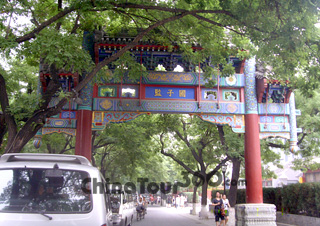 Imperial College
Imperial College Beijing Guozijian Street
Beijing Guozijian Street
The Imperial College (Guo Zi Jian), also called the Imperial Central School or Imperial Academy, was the highest learning institute in the traditional educational system of ancient China after the Sui Dynasty (581 - 618). The Imperial College was usually located in the capital city of the dynasty such as Beijing, Luoyang, Kaifeng, Nanjing and Xian.
The Imperial College situated in the Guozijian Street (or Chengxian Street) in the Dongcheng District of Beijing was the Imperial College during the Yuan (1271 - 1368), Ming (1368 - 1644) and Qing (1644 - 1911) Dynasties (although most of its buildings were built during the Ming Dynasty). It was the last Imperial College in China and is an important national cultural asset.
The college is located to the west of the Confucian Temple and connects with the temple through a side gate. Established in 1287 during the Yuan Dynasty and subsequently enlarged several times, it attains its present dimensions during the reign of Emperor Qianlong of the Qing Dynasty. After the founding of the People's Republic in 1949, the Imperial College was completely renovated and the Capital Library was incorporated within its grounds.
Upon entering the main gate, visitors will be confronted by a pair of wells as well as the Taixue (Highest Scholarship) Gate, also known as the Jixian (Assembled Virtue) Gate. Inside this gate is a glazed tile memorial archway with bell and drum towers standing to the east and west. In front of the gate is the famous Biyong (Jade Disc) Hall. The square pavilion, which lies in the center of a circular pond, has a double-eave roof surmounted by a gilded sphere. The pond is crossed by four marble bridges and provided on four sides with stone spouts in the shape of dragon's heads. It was here that the emperor came occasionally to expound the classics to an audience consisting of civil and military officials from the imperial court and students of the Imperial College.
The east and west auxiliary halls of the Biyong Hall originally housed the Qianlong Stone Scriptures. In the middle of the 18th century, Emperor Qianlong ordered to have the Thirteen Classics engraved in stone. To carry out his order, a scholar named Jiang Heng spent 20 years carving the 630,000 Chinese characters onto 189 stone tablets. Today these tables are located to the east of the Taixue Gate.
Behind the Biyong Hall stands the former Chongwen (Exalted Literature) Pavilion, this used to be a library during the Yuan Dynasty. Later its name was changed to the Yilun (Ethics) Hall. Here the emperor and other noted scholars gave lectures during the period before the Biyong Hall was built. Now it is one of the reading rooms of the Capital Library.
![]() Entrance Fee: CNY 30 (through ticket including the Confucius Temple and the Imperial College)
Entrance Fee: CNY 30 (through ticket including the Confucius Temple and the Imperial College)
![]() Transportation:
Transportation:
A. Bus Routes:
Take Bus No. 13, 116,117 or 684 and get off at Yonghegong (Lama Temple).
Take Bus No. 104, 108, 113, 124, 758 or 850 and get off at Fangjia Hutong.
B. Subway: Take Subway Line 2 or 5 and get off at Yonghegong Station.
![]() Opening Hours: 08:30 - 16:30
Opening Hours: 08:30 - 16:30








